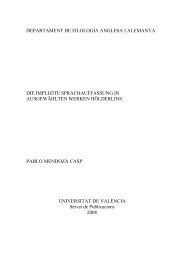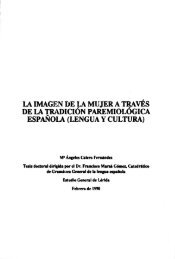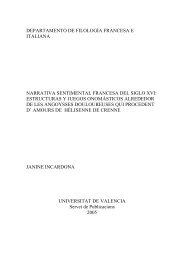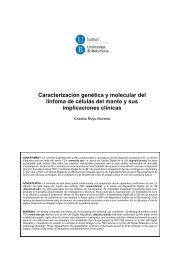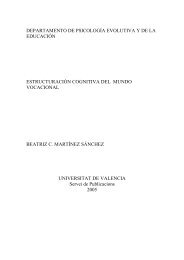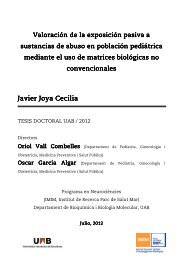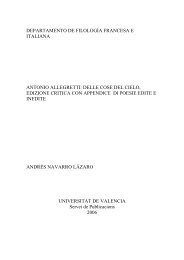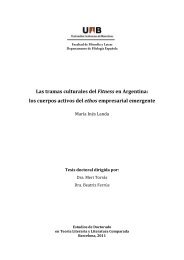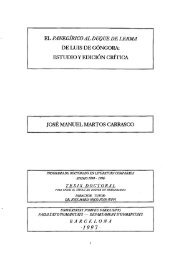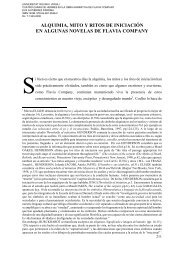- Page 1 and 2:
La recepción de “lo primitivo”
- Page 3:
A mis padres iii
- Page 7 and 8:
Agradecimientos Debo un especial re
- Page 9:
Un proyecto de tesis como éste no
- Page 12 and 13:
xii
- Page 14 and 15:
mayoría de los países europeos, l
- Page 16 and 17:
teórico y los tres siguientes anal
- Page 18 and 19:
figuras (maniquíes) que pretendía
- Page 21 and 22:
Sumario Agradecimientos vii Resumen
- Page 23 and 24:
5. ANÁLISIS DEL PALACIO DE LAS MIS
- Page 25 and 26:
1. APRECIACIONES DE “LO PRIMITIVO
- Page 27 and 28:
dificultades ya heredadas desde las
- Page 29 and 30:
esculturas que se exponían. Dado q
- Page 31 and 32:
obra de Goldwater porque trata un t
- Page 33 and 34:
simple sin necesidad de detalles pa
- Page 35 and 36:
que no tiene en cuenta que dentro d
- Page 37 and 38:
parte, William Rubin menciona que l
- Page 39 and 40:
emplazado en el museo sigue, inevit
- Page 41 and 42:
Un grabado en madera de 1505 instru
- Page 43 and 44:
estamos. Allí está siempre la rel
- Page 45 and 46:
Con esta afirmación todo el que ll
- Page 47 and 48:
grandes corruptoras de la inocencia
- Page 49 and 50:
Aunque todos estos escritos tampoco
- Page 51 and 52:
A la par que la tesis de Darwin, ta
- Page 53 and 54:
aza diferente a los occidentales ar
- Page 55 and 56:
escayola de los cuerpos 67 …Es lo
- Page 57 and 58:
cuarto y quinto. Finalmente, el des
- Page 59 and 60:
Una de las primeras referencias sob
- Page 61 and 62:
Philippe Peltier, en el catálogo d
- Page 63 and 64:
antropología cultural y social y a
- Page 65 and 66:
estancias en el Congo. Pero entre s
- Page 67 and 68:
más tarde ellos mismos asistieron
- Page 69 and 70:
a) Las primeras colecciones de obje
- Page 71 and 72:
Durante el siglo XVI en el que vivi
- Page 73 and 74:
Las joyas y los objetos suntuarios
- Page 75 and 76:
Pérouse, Vancuver…navegaciones d
- Page 77 and 78:
procedentes de la llamada “expedi
- Page 79 and 80:
finalizado el edificio que tenía q
- Page 81 and 82:
europeas, en contacto con August Pa
- Page 83 and 84:
donaciones de diversos tipos al Mus
- Page 85 and 86:
de no haber tenido la intención de
- Page 87 and 88:
califica a los objetos como toscos
- Page 89 and 90:
Por otra parte, podrían tratarse t
- Page 91 and 92:
1914 la actividad religiosa en torn
- Page 93 and 94:
graves problemas en la búsqueda de
- Page 95 and 96:
la Orden Capuchina tiene en Sarriá
- Page 97 and 98: Apéndice documental, CAPÍTULO 1:
- Page 99 and 100: 3. Ídolo de China llamado Bamba En
- Page 101 and 102: Pàgina 1 Biblioteca Museu Víctor
- Page 103 and 104: Pàgina 3 Biblioteca Museu Víctor
- Page 105 and 106: Pàgina 5 Biblioteca Museu Víctor
- Page 107 and 108: Pàgina 2 Biblioteca Museu Víctor
- Page 109 and 110: - 77 -
- Page 111 and 112: 2. EL CONTEXTO COLONIAL Y LAS EXPOS
- Page 113 and 114: cuales fueron los motivos que impul
- Page 115 and 116: En todo el proceso imperialista, lo
- Page 117 and 118: A finales del XIX las escasas colon
- Page 119 and 120: En 1909 se produce un nuevo desastr
- Page 121 and 122: se realizó un intenso seguimiento
- Page 123 and 124: junto a otros, recogen piezas Sundi
- Page 125 and 126: de viaje de un español en el golfo
- Page 127 and 128: Zabala, 210 quien le acompañó en
- Page 129 and 130: debe ser en extremo dolorosa, tiene
- Page 131 and 132: acompañan a las descripciones que
- Page 133 and 134: cocodrilos que bien podrían ser re
- Page 135 and 136: africanas en las arcas de Alfonso X
- Page 137 and 138: empresarios catalanes como para gar
- Page 139 and 140: considere conveniente para la defen
- Page 141 and 142: Comerç, Industria i Navegació de
- Page 143 and 144: presentados. El problema lo ponen d
- Page 145 and 146: principal que dio lugar a este tipo
- Page 147: también es un mirador por el que d
- Page 151 and 152: por lo que así comenzaría lo que
- Page 153 and 154: del canal dan buena cuenta del inte
- Page 155 and 156: Il y avait de cela, mais il y avait
- Page 157 and 158: El teatro annamita 287 de la Exposi
- Page 159 and 160: pesadas cargas y las grandes espera
- Page 161 and 162: una vez más, la población de las
- Page 163 and 164: Sir Samuel Baker 299 o sir Richard
- Page 165 and 166: obtener información sobre lo que i
- Page 167 and 168: mismas exposiciones. El Museo Arque
- Page 169 and 170: y como ya hemos expuesto en el caso
- Page 171 and 172: hubiera detenido, España presenta
- Page 173 and 174: Bruselas en 1910…todos ellos de c
- Page 175 and 176: otra parte, según el arquitecto Ig
- Page 177 and 178: suceden incluso diferentes intentos
- Page 179 and 180: Por otra parte, la contraportada fi
- Page 181 and 182: Es una manera de testimoniar el res
- Page 183 and 184: demás artistas del Oriente” 352
- Page 185 and 186: que detallan aspectos muy relevante
- Page 187 and 188: Apéndice documental, CAPÍTULO 2:
- Page 189 and 190: - 157 -
- Page 191 and 192: 2. Estatua de antepasado fang. Expe
- Page 193 and 194: 4. Carta del Instituto Colonial al
- Page 195 and 196: 5. “Exposición Colonial de Ámst
- Page 197 and 198: 7. Taberna de los vinos de Jerez en
- Page 199 and 200:
9. “El célebre Aïcha”. Exposi
- Page 201 and 202:
incalculable mérito artístico. Oc
- Page 203 and 204:
y el peligroso Ara que anotar. Y en
- Page 205 and 206:
3. LA EXHIBICIÓN DE OBJETOS ETNOGR
- Page 207 and 208:
civilización de los indígenas de
- Page 209 and 210:
Tratándose entonces de una exhibic
- Page 211 and 212:
a) Primeras impresiones de los nati
- Page 213 and 214:
asistir al Circo Ecuestre de la ciu
- Page 215 and 216:
produjo hasta el 22 de septiembre,
- Page 217 and 218:
un buen ejemplo de ello. ¿Qué mej
- Page 219 and 220:
protector del buen tiempo y el de l
- Page 221 and 222:
verdaderos edificios cimentados), q
- Page 223 and 224:
apoyada en el tronco y era objeto d
- Page 225 and 226:
de uno de los primeros acontecimien
- Page 227 and 228:
En opinion de Nicolas Bancel, 248 e
- Page 229 and 230:
al parecer sí queda claro entre la
- Page 231 and 232:
el equipo municipal consiguió real
- Page 233 and 234:
3.000 m². Portugal ocupó 22 m² d
- Page 235 and 236:
sala adjacent que porta el seu nom
- Page 237 and 238:
exposición de 1887, pero, por las
- Page 239 and 240:
después de la Exposición de Filip
- Page 241 and 242:
cobrar estipendios que conociendo t
- Page 243 and 244:
que acogió la exposición en 1887.
- Page 245 and 246:
Las declaraciones de Pompeu Gener c
- Page 247 and 248:
conocido como “Negre de Banyoles
- Page 249 and 250:
queda claro si sólo las cigarreras
- Page 251 and 252:
d) La exhibición de personas en la
- Page 253 and 254:
ocupó Succi durante su ayuno para
- Page 255 and 256:
1. Texto en el pie de la escultura
- Page 257 and 258:
3A. Fragmento de un grabado sobre l
- Page 259 and 260:
4. Instalaciones japonesas en la Ex
- Page 261 and 262:
6. Interior del Pabellón Central d
- Page 263 and 264:
7B. Ilustración del Bahay instalad
- Page 265 and 266:
4. LA EXHIBICIÓN DE OBJETOS ETNOGR
- Page 267 and 268:
Aunque los ashantis fueron fotograf
- Page 269 and 270:
La tribu ashanti llega a Barcelona
- Page 271 and 272:
Al visitarles por primera vez, me p
- Page 273 and 274:
En la segunda caricatura, titulada
- Page 275 and 276:
y recíprocamente, con la misma fac
- Page 277 and 278:
Otros dos aspectos en los que los c
- Page 279 and 280:
Americana respecto de los igorrotes
- Page 281 and 282:
seres salvajes, habitantes de los b
- Page 283 and 284:
Tampoco se especifica en las cróni
- Page 285 and 286:
exhibidos. Así como para los ashan
- Page 287 and 288:
decaído espíritu nacional” ocur
- Page 289 and 290:
de noviembre” con los objetivos d
- Page 291 and 292:
ámbito fue el de la Exposición de
- Page 293 and 294:
vimos en el desarrollo del capítul
- Page 295 and 296:
Colonia y el stand de los Misionero
- Page 297 and 298:
producen un sonido característico,
- Page 299 and 300:
crear riqueza en la industria y com
- Page 301 and 302:
Dinamarca, Francia, Hungría, Itali
- Page 303 and 304:
objetos enviados por las misiones q
- Page 305 and 306:
esfuerza en mostrar la escuela a la
- Page 307 and 308:
expositivo se atribuye a la Exposic
- Page 309 and 310:
Apéndice documental, CAPÍTULO 4:
- Page 311 and 312:
1B. Texto de la ilustración “La
- Page 313 and 314:
3A. Texto de la ilustración: “IN
- Page 315 and 316:
4A. Xatart, sin título [Mujer asha
- Page 317 and 318:
6. Cartel de la Exposición General
- Page 319 and 320:
8. Portada y tres páginas con ilus
- Page 321 and 322:
10A. Texto en la ilustración: “S
- Page 323 and 324:
11. Cartel de la Exposición Intern
- Page 325 and 326:
13. “Una tribu senegalesa en Mont
- Page 327 and 328:
sentencia en el hecho de que en el
- Page 329 and 330:
297
- Page 331 and 332:
5. ANÁLISIS DEL PALACIO DE LAS MIS
- Page 333 and 334:
Motu Proprio Quoniam tam praeclara
- Page 335 and 336:
colección de descubrimientos prehi
- Page 337 and 338:
Empieza así la tensión entre la I
- Page 339 and 340:
manifiesto, varias veces, la necesi
- Page 341 and 342:
(Oceanía) a cargo de los Misionero
- Page 343 and 344:
exhibición misional en España cel
- Page 345 and 346:
Misionera Protestante erige un kamp
- Page 347 and 348:
hecho expositivo, sino de lo que se
- Page 349 and 350:
En la tarde del 29 de junio de 1929
- Page 351 and 352:
misioneras y, en consecuencia, de l
- Page 353 and 354:
República y en 1939 se convirtió
- Page 355 and 356:
orden, de tal manera que se pudiera
- Page 357 and 358:
5.5. La representación del Otro: l
- Page 359 and 360:
Damas Negras. 501 Precisamente, la
- Page 361 and 362:
se veía a Colón dispuesto a empre
- Page 363 and 364:
epresentan dos hermanas de esta ord
- Page 365 and 366:
trató de un gran acontecimiento de
- Page 367 and 368:
los conocimientos e investigaciones
- Page 369 and 370:
sobre los orígenes de los estudios
- Page 371 and 372:
5.7. El Pabellón de las Misiones:
- Page 373 and 374:
evangelización en los cuatro conti
- Page 375 and 376:
que se ha podido recopilar sobre el
- Page 377 and 378:
obra maestra de la Orfebrería de T
- Page 379 and 380:
presuntas armas utilizadas en el ma
- Page 381 and 382:
FIGURAS DE ANTEPASADO/PRIMORDIALES
- Page 383 and 384:
stands. En la revista La Hormiga de
- Page 385 and 386:
astante dificultosa. En ausencia de
- Page 387 and 388:
Valladolid y el Museo Oriental del
- Page 389 and 390:
tribus que vivían en las montañas
- Page 391 and 392:
distinguir las piezas en ellas exhi
- Page 393 and 394:
permitiera observar, con mayor clar
- Page 395 and 396:
20. Construcciones chinas (maquetas
- Page 397 and 398:
2. Anverso invitación al acto de i
- Page 399 and 400:
4. Anuncio de la Magna Exposición
- Page 401 and 402:
7A. Dibujo de la fachada principal
- Page 403 and 404:
8A. Texto en la ilustración: “Fr
- Page 405 and 406:
8D. Texto en la ilustración: “In
- Page 407 and 408:
10. Texto en la ilustración: “Tr
- Page 409 and 410:
12A. Ilustración que representa a
- Page 411 and 412:
13. Leyenda izquierda de la fotogra
- Page 413 and 414:
15A. Instrucciones sobre los objeto
- Page 415 and 416:
ujería... 6) Forma de las habitaci
- Page 417 and 418:
17B. En el Palacio de las Misiones.
- Page 419 and 420:
18. Figura 863/208 y fotografía de
- Page 421 and 422:
20A. Texto en la ilustración: “D
- Page 423 and 424:
21A. Texto en la ilustración: “A
- Page 425 and 426:
2683- Colección de bastones; magn
- Page 427 and 428:
23B. Detalle de la vitrina anterior
- Page 429 and 430:
25. Representaciones de tipos filip
- Page 431 and 432:
399
- Page 433 and 434:
CONCLUSIONES El presente trabajo se
- Page 435 and 436:
marcos, de entre ellos 1.360 eran d
- Page 437 and 438:
Así como en Madrid se contó con l
- Page 439 and 440:
mencionados fueron, por tanto, una
- Page 441 and 442:
409
- Page 443 and 444:
BIBLIOGRAFÍA Publicaciones en seri
- Page 445 and 446:
Catálogo de los objetos que la Rep
- Page 447 and 448:
MALASPINA, Alejandro, La expedició
- Page 449 and 450:
Exposición de culturas primitivas
- Page 451 and 452:
ARCHER-STRAW, Petrine, Negrophilia,
- Page 453 and 454:
BLACHÈRE, Jean-Claude, Les totems
- Page 455 and 456:
CARR, C. y NEITZEL, J. (eds.), Styl
- Page 457 and 458:
CURTIS, Melinda (ed.), The search f
- Page 459 and 460:
FERNÁNDEZ, Cristóbal, Misiones y
- Page 461 and 462:
GRACQ, Julien, 42 rue Fontaine, l'a
- Page 463 and 464:
JULES-ROSETTE, Bennetta, The messag
- Page 465 and 466:
LIPPARD, Lucy R., Mixed blessing. N
- Page 467 and 468:
MONTERO, Antonio, “Adquisiciones
- Page 469 and 470:
PUIG ROVIRA, Francesc Xavier, “La
- Page 471 and 472:
SAID, Edward, Orientalism, Nueva Yo
- Page 473 and 474:
- Filipinas: Obras selectas, Vallad
- Page 475 and 476:
WESTHERMAN, Frank, El negre i jo, B



